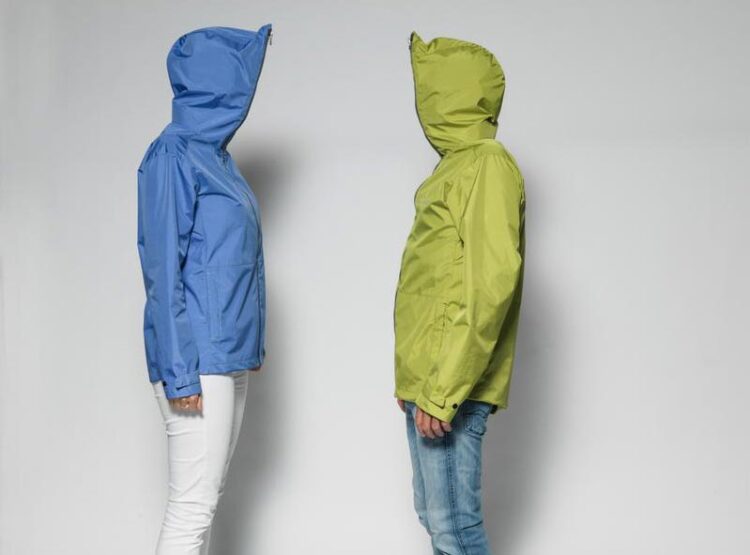A jacket from a jacket from a jacket …

The green color of the jacket shows that recycled materials had been incorporated.
(c) Schoeller Textil AG
Manufacture, wear, wash, incinerate: This typical life cycle of garments, which pollutes the environment, is to be changed in the future – towards principles of circular economy with recycling at its core. Using an outdoor jacket made from PET bottles and recycled materials, Empa researchers have investigated whether the product actually delivers what the idea promises.
At first glance, it’s a normal rain jacket: three layers of polyester, a lining on the inside, a water vapor-permeable membrane on top and water-repellent fabric on the outside, with a hood. But the zipper makes you wonder. Instead of ending at collar height, it pulls up over the forehead … – who would pull it that far?
The explanation is given by Annette Mark from textile manufacturer BTK Europe, who contributed to this product. The zipper is intended to be an eye-catcher – and is primarily for recycling: Sewn tight with a thread that dissolves in boiling water, it is easier to remove than two fasteners. “Pull once and you’re done,” says the expert on textiles and recycling. The light green color is also due to recycling: The raw material, a granule made from a mixture of different but single-variety textiles, is dark green – and melting and spinning out the material for new yarns lightens it.
Circular economy within textile industry
Magnetic buttons, seams, hems: Every detail of the jacket follows the Design2Recycle approach, as it says on the Wear2wear website. Six companies from Europe’s textile industry have joined forces in this consortium to promote circular economy. After all, more than 70 percent of all textiles produced worldwide end up in landfills or incinerators without being recycled.
How can circular economy be acheived in this industry? A team from Empa’s Technology and Society lab took a closer look at the jacket and its environmental impact using life cycle analyses over a four-year period of use; including washing it three times. The candidates: a jacket produced without circular economy methods, the “starter version” of the jacket available since 2019 in blue – with an outer layer made of polyester derived from used PET bottles – and the green version from the subsequent recycling process, in which unavoidable material losses are replaced by new polyester.
The researchers’ analyses show that the recycled products perform better – in eleven environmental risk categories, including global warming, toxicity to ecosystems and water scarcity. There are strikingly large advantages in air pollution, for example, because fewer pollutants are released without incineration, as well as in water scarcity, especially for the green jacket after the first recycling “loop,” for which PET bottles are no longer used.
Other insights from the analyses: In terms of greenhouse effect, the maximum benefit is a good 30 percent. And the use of PET bottles does not bring any major ecological benefits. What is decisive, on the other hand, is the number of recycling cycles to produce new jackets: The balance improves from jacket to jacket – provided the quality of the polyester remains high enough.
In practice, this is challenging, as Mark explains: “Depending on the origin, the raw material sometimes differs significantly.” If the fibers have been coated with certain additives, the nozzles of the spinning machines can become clogged. And in general, the quality decreases with the number of recycling cycles: more irregular structures of the yarn and lower strength.
Annette Mark’s conclusion on the Empa analyses: “very realistic” and useful for improvements. “The cooperation was very good,” she says, “full transparency and no compromises.” The researchers also found the collaboration fruitful. “Open collaboration between science and industry is enormously important,” says former team member Gregor Braun, who has since left Empa and now works as a consultant for sustainability. “Sustainability and circular economy can work well together.”
Will the jacket become a market success? “The textile industry is in a state of upheaval. A rethinking is taking place right now that we shouldn’t miss,” says Annette Mark. But large corporations that are already developing similar products “have completely different options.” After all, talks are underway with a sportswear manufacturer – for a fleece jacket, for which the Empa findings could also be useful.
Wissenschaftliche Ansprechpartner:
Dr. Roland Hischier
Technology and Society
Phone +41 58 765 78 47
roland.hischier@empa.ch
Annette Mark
BTK Europe
Phone +41 79 201 35 05
annette.mark@btkeurope.com
Editor / Media contact
Norbert Raabe
Communication
Phone +41 58 765 44 54
redaktion@empa.ch
Weitere Informationen:
https://www.empa.ch/web/s604/jacken-aus-jacken Empa Media release
Media Contact
All latest news from the category: Ecology, The Environment and Conservation
This complex theme deals primarily with interactions between organisms and the environmental factors that impact them, but to a greater extent between individual inanimate environmental factors.
innovations-report offers informative reports and articles on topics such as climate protection, landscape conservation, ecological systems, wildlife and nature parks and ecosystem efficiency and balance.
Newest articles

Superradiant atoms could push the boundaries of how precisely time can be measured
Superradiant atoms can help us measure time more precisely than ever. In a new study, researchers from the University of Copenhagen present a new method for measuring the time interval,…

Ion thermoelectric conversion devices for near room temperature
The electrode sheet of the thermoelectric device consists of ionic hydrogel, which is sandwiched between the electrodes to form, and the Prussian blue on the electrode undergoes a redox reaction…

Zap Energy achieves 37-million-degree temperatures in a compact device
New publication reports record electron temperatures for a small-scale, sheared-flow-stabilized Z-pinch fusion device. In the nine decades since humans first produced fusion reactions, only a few fusion technologies have demonstrated…





















